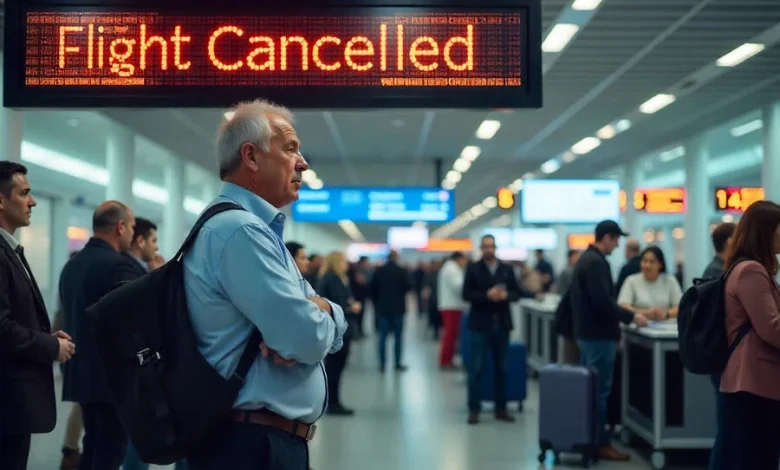Thousands of Passengers Grounded in US as Frontier, American, Jetblue, Delta, Alaska, and Other Airlines Cancel 172 Flights and Cause 4100 Delays Affecting Chicago, Arlington, Pennsylvania, Indianapolis, New York, Norfolk, and More

Published on
November 2, 2025
Thousands of passengers were grounded across US as Frontier, American Airlines, Jetblue, Delta, Alaska, and other major carriers canceled 172 flights and caused over 4,100 delays. The widespread disruptions, which affected airports in Chicago, Arlington, Pennsylvania, Indianapolis, LaGuardia, Norfolk, and many others, were triggered by a combination of operational challenges, staffing shortages, and airport congestion. The massive delays and cancellations left passengers stranded for hours, highlighting the vulnerabilities in the U.S. air travel system.
In an unprecedented travel disruption, thousands of passengers were stranded across various airports in the United States, with airlines such as Frontier, American, Jetblue, Delta, Alaska, and more being affected. On one chaotic day, over 172 flights were canceled, and 4,180 delays took place, causing significant travel headaches for both passengers and airport staff. Key hubs like Chicago, Arlington, Pennsylvania, Indianapolis, LaGuardia, Norfolk, and others became focal points of frustration for travelers. The massive flight disruptions not only disrupted the travel plans of thousands but also showcased the ongoing vulnerabilities within the air travel sector as airports struggle to cope with operational pressures and labor challenges.
A Day of Unrelenting Delays and Cancellations
The ripple effects of the disruptions were felt across the country, especially at major airports and regional hubs. The high number of flight cancellations and delays stemmed from a mix of factors, including labor shortages, weather-related issues, and airport congestion. Among the most impacted airports, Chicago O’Hare International (ORD) saw 211 delays and 7 cancellations. Passengers flying through LaGuardia (LGA) in New York City faced a combined total of 87 delays and 10 cancellations, while Orlando International Airport (MCO), another major hub, recorded 101 delays and 7 cancellations.
The day began with a wave of cancellations hitting key airports on both the East and West Coasts. In the nation’s capital, Washington Dulles International (IAD) reported 4 cancellations and 51 delays. Similarly, Miami International Airport (MIA) witnessed 114 delays and 5 cancellations, further underscoring the widespread nature of the disruptions.
Meanwhile, Boston Logan International (BOS) and Detroit Metro Wayne County (DTW) were not spared either, experiencing significant delays. Boston reported 98 delays and 5 cancellations, while Detroit had 48 delays and 6 cancellations.
The Airline Impact: Frontier, American, Delta, and Others
Several major carriers bore the brunt of the cancellations and delays. American Airlines had the highest number of delays at 682, along with 21 cancellations. This was followed closely by United Airlines, which experienced 470 delays and 23 cancellations. The Southwest Airlines fleet also faced 528 delays and 12 cancellations, creating havoc for passengers flying in and out of airports across the US.
Delta Air Lines, a major player in the aviation industry, was forced to cancel 39 flights, with an additional 444 delays across multiple airports. In terms of sheer volume, JetBlue also saw substantial disruption, with 24 cancellations and 201 delays affecting passengers at various airports like New York, Boston, and Fort Lauderdale.
Regional carriers were not exempt from the chaos. Smaller airlines like Spirit also faced 5 cancellations and 54 delays, while Air Canada recorded 12 cancellations and 164 delays, impacting travelers crossing the border or flying through major airports like New York’s LaGuardia and Chicago O’Hare.
Airport Infrastructure Struggles
A contributing factor to the large-scale delays and cancellations was airport congestion. Major hubs such as Chicago O’Hare, Orlando, LaGuardia, and Miami International saw hundreds of flights delayed, straining the existing airport infrastructure. Many of these airports were already operating at near capacity before the disruptions, making it even harder for airlines to efficiently manage flight schedules.
Delays were particularly felt in airports with limited gate availability or labor shortages. In some cases, airline crews were unable to quickly clear congested airspace or return to scheduled flights on time due to waiting for ground support. Even passengers who were lucky enough to make it onto flights still faced prolonged delays due to slow aircraft movements and crowded terminals. For travelers, the lack of clear communication from airlines further exacerbated the situation, leading to an atmosphere of confusion and frustration.
At LaGuardia Airport (LGA), known for its congestion, passengers faced long lines at check-in counters and security. Meanwhile, Chicago O’Hare‘s terminals were filled with anxious travelers watching the large LED boards above them flash with delays and cancellations. Travelers took to social media to voice their frustrations, and many voiced concerns about the growing strain on air traffic controllers and TSA staff.
Passengers Left in Limbo
While some airlines worked to accommodate passengers by offering rebooking options, others struggled to provide clarity. Affected passengers were left to navigate the unpredictable and overcrowded terminals, many of which had already seen delays throughout the day. Some travelers reported spending hours waiting for updated flight information, while others faced longer waiting times for rebooked flights.
For travelers with connecting flights, the disruptions meant missed connections and added stress. Some travelers who had flights booked with American Airlines and United Airlines were offered to take alternative routes, but only after hours of waiting at the gates.
In many cases, airport staff was overwhelmed by the sheer volume of passengers affected by the delays. They worked tirelessly to direct passengers to available customer service desks and rebooking counters, but given the number of flights that were impacted, it proved difficult to keep up with demand.
The Road Ahead: Addressing Aviation Industry Challenges
This massive disruption further highlights ongoing vulnerabilities in the US air travel system, especially as the country heads into the busy holiday season. While weather conditions and staffing shortages have been contributing factors to flight cancellations and delays, the overall issue of underpreparedness remains. Experts have warned that there is a need for the government and airlines to invest in more robust backup plans and staff training to mitigate such large-scale disruptions.
Additionally, airport infrastructure upgrades have become more urgent as air traffic continues to increase. Several US airports, particularly those in major metropolitan areas like Chicago, New York, and Miami, will need to modernize and expand to accommodate the growing demand for air travel. Upgrades in gate availability, staff training, and overall airport efficiency will play a key role in preventing similar chaos in the future.
As airlines continue to battle operational challenges, it remains to be seen how quickly they can adapt to meet growing passenger demands. The aviation industry has a long road ahead in improving its resilience and restoring confidence among passengers who are increasingly concerned about the reliability of air travel.
In conclusion, the travel disruptions that hit the United States yesterday had far-reaching consequences for both passengers and airlines. With 172 flight cancellations and more than 4,000 delays, passengers from Chicago, Arlington, Pennsylvania, Indianapolis, LaGuardia, Norfolk, and beyond were left stranded, frustrated, and uncertain about when they would be able to reach their destinations.
The airlines most affected, including Frontier, American Airlines, Jetblue, Delta, and others, faced immense operational challenges that rippled through the country’s air travel network. The increasing number of flight delays, coupled with congestion at major airports, emphasized the need for improved infrastructure and contingency planning.
Thousands of passengers were grounded across the US as Frontier, American Airlines, Jetblue, Delta, Alaska, and others canceled 172 flights and caused over 4,100 delays due to operational issues, staffing shortages, and airport congestion, particularly affecting major hubs like Chicago, LaGuardia, and Indianapolis.
Passengers, though stranded and delayed, must continue to navigate a challenging and often unpredictable air travel landscape. However, this chaotic day may serve as a wake-up call for the aviation industry to take the necessary steps to address the inefficiencies that continue to plague the sector. As we move into the busiest travel months of the year, the industry will need to adapt quickly to ensure smoother operations and to restore passenger trust in a world that’s more reliant than ever on air travel.





